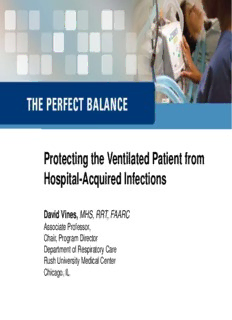
Protecting the Ventilate-Patient from Hospital-Acquired Infections PDF
Preview Protecting the Ventilate-Patient from Hospital-Acquired Infections
Protecting the Ventilated Patient from Hospital-Acquired Infections David Vines, MHS, RRT, FAARC Associate Professor, Chair, Program Director Department of Respiratory Care Rush University Medical Center Chicago, IL Acknowledgments • This lecture is sponsored by Teleflex • Member of The Council for Advances in Respiratory Therapy • Current Research funding from: • Covidien / Oridion Capnography, Inc Objectives • Upon completion of this module, participants should be able to: • Discuss the impact of HAI on health care costs and outcomes • Describe criteria to diagnose VAP and define VAC & IVAC • Discuss strategies to minimize HAI in MV patients and their associated evidence, such as humidification, circuit maintenance, cuff pressure, ETT modifications, hand hygiene, infection control, elevated HOB, oral hygiene, NIV, Daily SBTs, and use of bundles. 2010-0498 v1 Introduction • Hospital-acquired infection (HAI) • infection acquired in an acute care setting while receiving treatment for medical or surgical conditions.1,2. • Among the top 10 leading causes of death in the US.1 • 2002: ~1.7 million infected; ~100,000 died from HAIs. 1. Klevens RM, et al. Public Health Rep. 2007;122(2):160-166. 2. Morbidity and Mortality Weekly Report (MMWR). March 4, 2011/60(08);243-248. Introduction • Approx. 5% of hospital inpatients develop an HAI.1 • More Americans die per year from an HAI than from AIDS, breast cancer, and car accidents combined. • One half to two-thirds of such infections are preventable.2 STOP 1. Morbidity and Mortality Weekly Report (MMWR). March 4, 2011/60(08);243-248 2. McCaughey B. Unnecessary deaths: The human and financial costs of hospital infections. 3rd edition. New York, NY (2008) Risk factors and frequencies for HAIs • All hospitalized patients are susceptible to contracting an HAI. • At greater risk: young children, the elderly, the immunocompromised, and intensive-care patients. • Factors that increase risk of HAI: • long hospital stay • indwelling catheters, central lines, and ventilators • complications following surgery • failure of healthcare workers to wash hands • overuse of antibiotics Types of HAIs • Four categories of HAIs account for approximately 75% of infections in acute care settings: 1. Surgical site infections 2. Central-line–associated bloodstream infections 3. Ventilator-associated infections 4. Catheter-associated urinary tract infections Klevens, RM, Edwards J, Richards C, et al. Estimating Health Care Associated Infections and Deaths in U.S. Hospitals. Public Health Rep.2007;122(2):160-166. Rate of Occurrence of HAIs Figure 1. Rate of Occurrence for Healthcare Associated Figure 1. Rate of Occurrence f or Healthcare Associated Infections Inf ections.. Leading Types of Healthca re-Associated Infections Urinary Tract Infections Surgical Site Infections Bloodst ream Infections Pneumonia 0 5 10 15 20 25 30 35 40 % HAIs Nationally Klevens, RM, Edwards J, Richards C, et al. Estimating Health Care Associated Infections and Deaths in U.S. Hospitals. Public Health Rep.2007;122(2):160-166. Surgical Infections • Second most prevalent cause of HAIs. • A surgical infection may be acquired from: • contaminated surgical equipment, • inadequate surgical site preparation, • healthcare workers. • Surgical wound may become infected. • Wounds caused by trauma, burns, and ulcers may also become infected. Bloodstream Infections • Hospitalized patients often require an intravenous (IV) line or central access device. • Bacteria can invade the catheter insertion site, and enter the blood through the vein. • Bloodstream infections can be life-threatening. • The longer a catheter is in place, the greater the risk of infection. Girard R, et al. Prevention of hospital acquired infections: A Practical Guide. 2nd edition. WHO/CDS/CSR/EPH/2002.12.
Description: